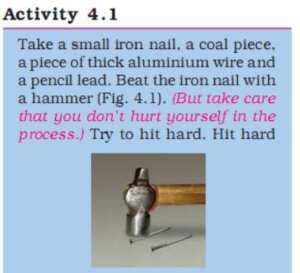Materials: Metals and Non-metals Activity solution Chapter 4 Class 8 Science
Table of Contents
Activity 4.1

Observation:
We observe that the nail flattens and become thin.
Explanation:
Metals are malleable, that means they can be shaped into thin sheets. When we strike the hammer the shape of the email changes and becomes flat.
Non-metals like coal and pencil lead are brittle and fragile. When we strike them with a hammer, they don’t flatten and shatter into pieces.
Application:
Kitchen utensils made of aluminium and other metal are made using this property.
Thin aluminium foils which are used to wrap food is a very thin sheet of aluminium. It is made by beating the aluminium.
See also: Activity solution Chapter 3 Synthetic fibres and plastics
Activity 4.2
Activity 4.2 has given a list of some common metals and non-metals. It asks us to check whether they conduct electricity or not.
Observation:
Iron and copper wire conduct electricity while coal and sulphur do not conduct electricity.
Explanation:
Metals have free electrons in their outer shells. When we connect metal with battery these electrons move. As a result, metals are a good conductor of electricity.
Non-metals do not have free electrons in their outer shell. So, they do not conduct electricity.
Inference/Conclusion:
Metals are good conductor of electricity while non-metals do not conduct electricity.
Application:
Rubber gloves are a very bad conductor of electricity. So, an electrician uses these gloves to avoid any electrocution
Activity 4.3
Activity 4.3 asks us to dissolve some rusted iron into water and know if the solution is acidic o basic.
The solution turns red litmus paper to blue.
Explanation:
Rust of iron is an oxide of iron. The metal oxide forms its hydroxide with water. As a result, they make the solution basic which turns the red litmus blue.
Fe2O + 6H2O → 2Fe(OH)3 + 3H2
Inference/Conclusion:
Metal oxides are basic in nature.
Activity 4.4
Activity 4.4 asks us to burn sulphur in a closed container and check its aqueous solution with litmus paper.
The aqueous solution turns the blue litmus red.
Explanation:
This activity is similar to the previous one Activity 4.3. Ther we used metal oxide (rust), here we are using non-metal oxide.
Non-metal oxides are electron acceptor. They accept electrons from OH- of water and forms an acidic compound. As a result, the solution becomes acidic and turn the blue litmus red. Here, the burning of sulphur forms sulphur dioxide.
This oxide reacts with water to form sulphuric acid.
S + O2 → SO2
SO2 + H2O → H2SO3(Sulphurous acid)
Inference/conclusion:
This experiment shows that non-metal oxides are acidic in nature.
Fact:
Acid rain: Atmospheric sulphur dioxide react with clouds and form sulphuric acid. When it rains, we call it acid rain. Mostly industries emit sulphur dioxide so, it is common in industrial areas.
Activity 4.5
Activity 4.5 asks us to put a small amount of sodium into a beaker filled with water.
Observation:
Sodium metal glows and makes the beaker warm.
We studied earlier activity 4.2 (rusted iron in water) that metal oxides from metal hydroxides with water. Sodium is a highly reactive metal. Here, sodium reacts with water and form sodium hydroxide. The reaction is spontaneous and we may hear a crackling sound as well. The reaction produces enormous heat and makes the beaker hot.
Inference:
Metals form metal hydroxides with water.
Warning: Do not touch sodium with a bare hand. Sodium may catch fire with the moisture and burn the skin. Always use a tong to handle sodium.
Activity 4.6
Activity 4.6 asks us to reacts various metals and non-metals with dilute hydrochloric acid and sulphuric acid: first at room temperature and secondly with a warm solution if a reaction does not occur at room temperature.
Observation:
Magnesium and aluminium are highly reactive metals they react spontaneous with both dilute HCl and dilute sulphuric acid. Here magnesium displaces hydrogen which gives a pop sound with a matchstick.
Iron is lesser reactive, it does not react with HCl at room temperature.
Copper lesser reactive than iron. It is placed below hydrogen in electropositive series. So, it does not displace hydrogen from either HCl and sulphuric acid.
Non-metals do not react with dilute acids.
Explanation:
Metals higher than hydrogen in electropositivity series displace hydrogen from acids and form soluble salts. This accompanies with the formation of hydrogen gas. H2 gas is highly inflammable. It burns with pop sound when the flame is brought to it.
M + Dil. HCl → MCl(metal chloride) + H2↑ (gas)
M + Dil. H2SO4 → MSO4(metal sulphate) + H2↑ (gas)
Inference:
The metal reacts with dilute acid and form hydrogen gas, while non-metals do not react with dilute acids.
Activity 4.7
Activity 4.7 asks us to react aluminium with dilute sodium hydroxide solution.
Observation:
Aluminium reacts spontaneously and liberates gas which burns with a pop sound.
Al + NaOH → Al(OH)3 + H2↑
Explanation:
Metals react with dilute bases and form its hydroxide. The process accompanies with the liberation of hydrogen gases. H2 gas burns with the sound when we bring the flame to it.
See also:
Activity Solution Synthetic Fibres and Plastics
Microorganisms Friend or foe Activities
Activity Solution Crop Production and Management
Materials: Metals and Non-metals Activity solution Chapter 4 Class 8 Science
Ref: NCERT CH4
Where is 4.8
The onky thing which I wnt to say is thanks
I understood well….
I will be really thankful to you……
Excellent sir/mam
Very nice explanation..
Activity 4.8